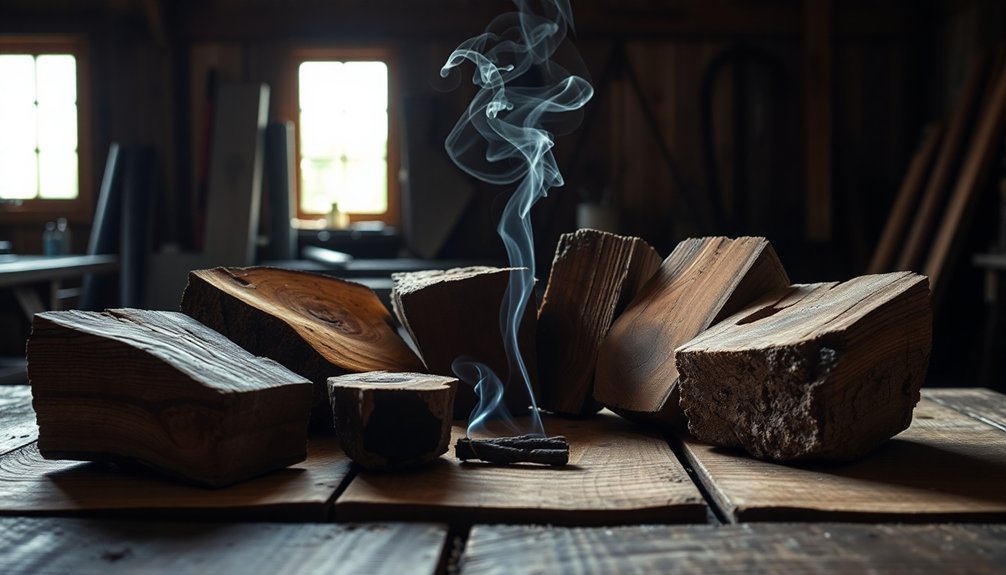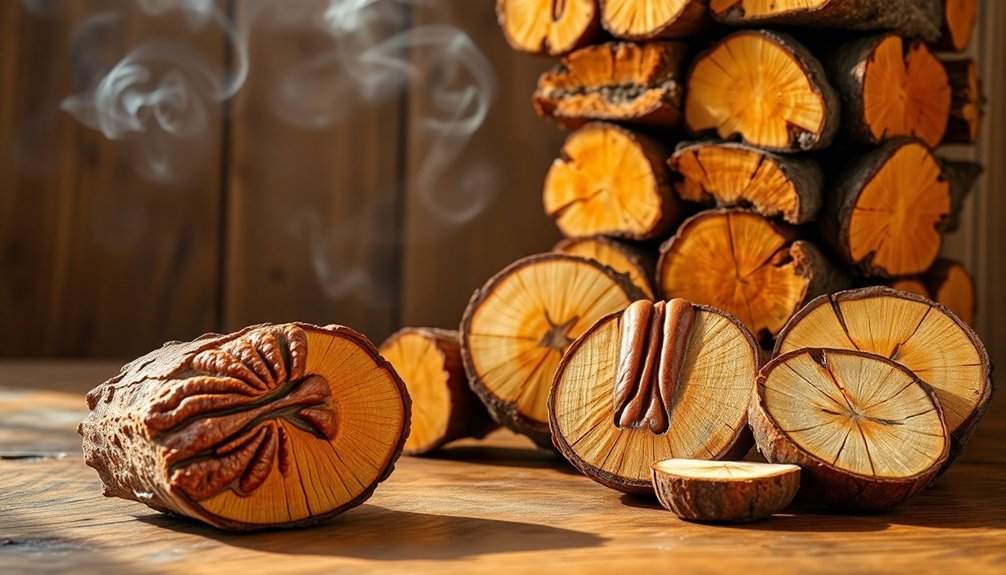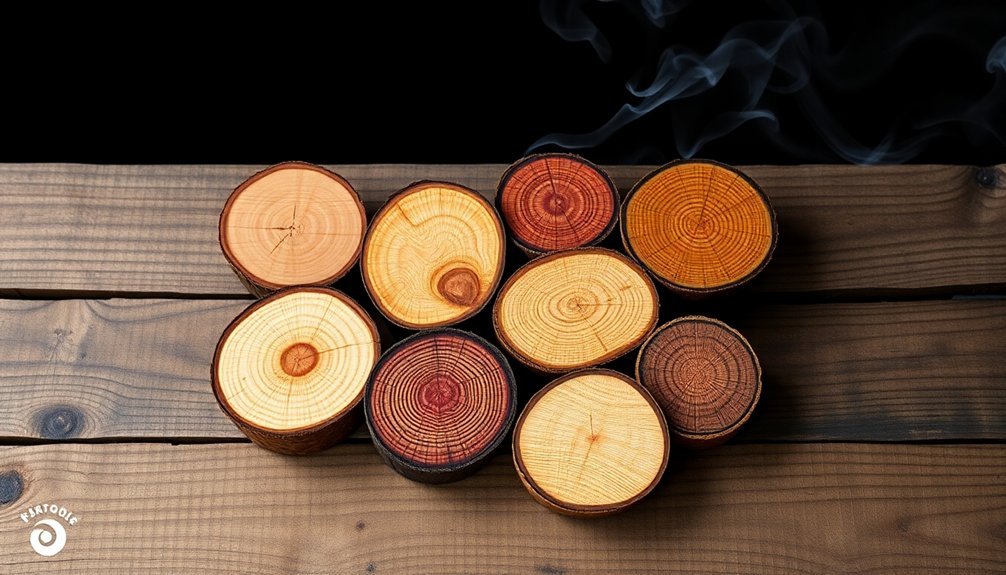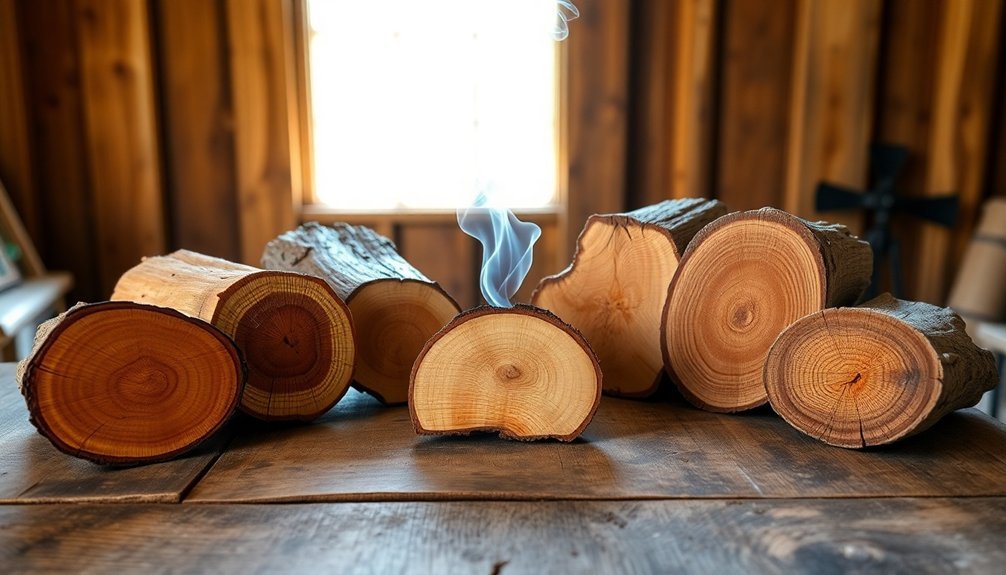When you're selecting smoking woods for BBQ mastery, focus on these proven hardwoods: hickory, oak, maple, pecan, apple, cherry, alder, and mesquite. Hickory delivers a robust, bacon-like flavor perfect for long smoking sessions, while oak offers a strong yet balanced profile that pairs well with most meats. Maple and pecan provide sweet, mild flavors ideal for poultry and pork, and fruit woods like apple and cherry create subtle, delicate smoke profiles. Your choice of wood dramatically impacts your BBQ's final taste, and each hardwood brings its unique characteristics to transform your smoking game. Let's explore how to master these essential BBQ woods.
The Art of Wood Selection

In the world of BBQ smoking, wood selection stands as the foundation of flavor mastery. You'll need to understand that different woods create distinct flavor profiles, and choosing the right one can make or break your BBQ experience.
Start by matching your wood to your meat. If you're smoking delicate proteins like chicken or fish, opt for mild woods such as alder, apple, or cherry. These woods impart a subtle, fruity sweetness without overwhelming the meat's natural flavors. A smoker box can help control smoke output when using these milder woods.
For red meat and game, you'll want stronger woods like oak or mesquite, which provide the robust smokiness these meats can handle.
Don't hesitate to experiment with wood combinations. You can pair pecan with fruitwoods or mix oak with other hardwoods to create unique flavor profiles.
However, always avoid softwoods like pine or cedar – they're packed with resins that produce harmful smoke and can ruin your food.
Remember that burn characteristics matter too. Oak and hickory offer long, hot burns perfect for extended smoking sessions, while mesquite burns hot and fast.
If you're planning a long smoke, consider woods like maple or pecan that provide steady, consistent heat.
Hickory: King of BBQ Woods
When you're looking to achieve that classic BBQ flavor, hickory stands out as the undisputed king of smoking woods with its robust, bacon-like taste profile.
You'll find that hickory's strong yet balanced smokiness brings a deep, penetrating flavor that's perfect for long, slow cooking sessions, especially with larger cuts of meat like pork shoulders and beef briskets. This exceptional wood's high density of 27 pounds per cubic foot ensures a longer-lasting and more consistent smoke output.
Its consistent burn rate and high lignin content guarantee your meat develops that sought-after dark outer crust while maintaining its natural juices throughout the smoking process.
Classic Deep Smoky Flavor
Mastering the art of hickory smoking elevates your BBQ game to legendary status. You'll discover that hickory's dense structure and low moisture content create an ideal burning profile, providing consistent heat and that coveted deep, smoky flavor that's become synonymous with authentic BBQ.
When you're smoking with hickory, you'll get a rich, savory profile with subtle bacon-like undertones that's particularly magical with pork and red meats. Balancing with other woods has become a common practice among pitmasters. The wood's natural sugars caramelize during the smoking process, forming a delectable outer crust on your meat that's simply irresistible.
You'll want to exercise restraint with hickory smoke, as too much can overwhelm your meat with bitterness. Consider combining it with milder woods like cherry or oak to create a more balanced flavor profile.
For best results, use hickory with larger cuts like pork shoulders, ribs, and beef brisket, where the extended cooking time allows the smoke to penetrate deeply without overpowering.
Don't forget that proper storage is essential to maintain your hickory's quality. Keep it in a dry place, and if you're storing fresh-cut hickory, seal the ends to prevent warping and cracking.
Perfect For Slow Cooking
Throughout the BBQ world, hickory's reputation as the king of smoking woods stems from its exceptional slow-cooking properties. You'll find that hickory burns hotter and longer than other hardwoods, making it perfect for those marathon smoking sessions where maintaining consistent temperature is vital.
When you're tackling larger cuts like pork shoulders or beef roasts, you won't need to feed the fire as frequently.
You can use hickory with virtually any smoking setup, whether you're working with a ceramic grill, offset smoker, or traditional kettle grill. For best results, you've got two approaches: either soak your wood chunks for 30 minutes before placing them over the heat source, or use them dry and let them smolder naturally.
If you're new to hickory, try mixing it with milder fruit woods like cherry or apple to balance its robust, savory flavor profile.
To maintain hickory's rich, bacon-like tang, you'll want to store your wood properly. Keep it elevated off the ground, preferably in specialized boxes or on firewood racks.
This protection from moisture and pests guarantees your hickory will deliver that signature deep, sweet-savory smoke whenever you're ready to fire up the smoker.
Versatile Oak Smoking Techniques

Oak smoking stands as one of the most adaptable techniques in barbecue, offering both versatility and reliability for pitmasters.
You'll find that oak delivers a strong yet balanced smoke profile that won't overpower your meats, making it particularly effective for beef, lamb, and sausages.
When you're working with oak, start by adding small chunks directly to your hot coals – there's no need to soak the wood first, as this only creates steam instead of flavorful smoke.
You'll want to use seasoned oak to avoid the pungent smoke that can come from excess sap.
What makes oak truly versatile is its ability to pair with other woods.
You can combine it with hickory for a more intense smoke flavor, cherry for a fruity note, or apple for sweetness.
For red meats like brisket and ribs, use oak as your primary wood.
When smoking poultry or delicate fish, mix oak with milder woods like apple or cherry to achieve a more balanced profile.
The key is adjusting the ratio of oak to other woods based on your desired flavor intensity and the type of meat you're smoking.
Maple's Sweet Smoking Profile
You'll appreciate maple wood's gentle sweet profile, which adds a subtle hint of caramelized sugar without overpowering your meats.
This versatile smoking wood shines when paired with poultry and pork, bringing out their natural flavors while imparting a balanced sweetness.
When smoking with maple, you can count on its consistent performance with both hot and cold smoking techniques, making it an excellent choice for beginners and seasoned pitmasters alike.
Gentle Sweet Flavor Notes
Maple's sweet-smoking profile stands as a demonstration to nature's delicate touch in BBQ. You'll notice its subtle hint of caramelized sugar when the smoke meets your meat, creating a gentle sweetness that won't overpower your carefully selected ingredients. This delicate balance makes maple wood an excellent choice for both beginners and seasoned pitmasters.
When you're smoking with maple, you'll appreciate its versatility across different cooking techniques. Whether you're using chips, chunks, or logs, you'll get that pleasant, appetizing aroma that makes outdoor cooking even more enjoyable. The wood burns cleanly and consistently, producing minimal sparks and emissions while maintaining a steady temperature for your cook.
You can confidently pair maple wood with lighter foods like squash and root vegetables, as its neutral base won't overwhelm their natural flavors. For an extra dimension to your BBQ, try combining maple with other smoking woods to create your signature flavor profile.
The wood's balanced characteristics shine through in everything from delicate cheeses to hearty meats, making it a reliable choice for your smoking arsenal.
Best Meats For Maple
Pitmasters seeking the perfect wood-meat pairing will find maple's sweet smoking profile particularly well-suited for poultry, pork, and delicate fish varieties.
When you're smoking chicken, turkey, or game birds, maple wood imparts a gentle sweetness that enhances rather than masks the meat's natural flavors. The same principle applies to pork cuts like chops, loin, and ham, where maple's subtle smoke creates a beautiful harmony with the meat.
For fish smoking enthusiasts, you'll get excellent results with trout, salmon, and Arctic char. Maple's mild nature won't overpower these delicate proteins, instead offering a balanced flavor enhancement that'll impress your guests.
You can even use maple wood for smoking cheese and vegetables, as it won't dominate their subtle taste profiles.
Unlike more intense woods like hickory or mesquite, maple's medium smoke intensity makes it perfect for both quick cooks and longer smoking sessions.
You'll find it especially valuable when hosting backyard gatherings, as its pleasant aroma creates an inviting atmosphere.
For added complexity, try mixing maple with other hardwoods or soaking it in apple juice to create unique flavor combinations.
Pecan Smoke Mastery

Among the noble smoking woods, pecan stands out as a masterful choice for its mild, sweet profile and remarkable versatility. You'll discover its subtle nutty and fruity undertones enhance your smoked meats without overpowering their natural flavors. When you're smoking with pecan, you'll appreciate its clean burn and minimal creosote buildup.
To master pecan smoking, start with well-seasoned wood that's free from mold and maintain your smoker between 225°F to 250°F. You don't always need to soak your wood chips, but if you do, you'll get enhanced smoke production.
| Meat Type | Smoke Intensity | Best Results |
|---|---|---|
| Poultry | Medium-Light | Excellent |
| Pork | Medium | Outstanding |
| Beef | Medium | Very Good |
| Fish | Light | Good |
| Game | Medium | Very Good |
While pecan wood might be harder to find than hickory or oak, it's worth seeking out for its exceptional qualities. You'll find it particularly effective with poultry and pork, where its delicate sweetness shines through. If you're after intense smokiness, you might want something stronger, but for balanced, nuanced flavor, pecan's your ideal choice.
Regional Wood Smoking Traditions
Throughout America's diverse BBQ landscape, distinct regional wood smoking traditions have evolved based on local resources and cultural heritage. In the Southern United States, you'll find hickory and oak dominating the scene, with pecan making frequent appearances in long smoking sessions.
Georgia particularly favors the robust flavors of hickory and oak combinations.
Texas showcases four distinct BBQ styles, each with its preferred woods. Central Texas pitmasters swear by aged post oak for their brisket, while East Texas traditionalists rely on hickory.
You'll encounter mesquite in West and South Texas, where its intense heat and bold flavor profile shine.
The Midwest's smoking traditions blend Southern influence with regional preferences, primarily featuring hickory and oak.
You'll also find applewood being used for pork and poultry, adding a subtle sweetness to the meat.
In the Southwest and Western regions, mesquite reigns supreme, reflecting centuries of use by indigenous peoples and settlers.
The harsh desert environment has shaped these traditions, with mesquite's intense heat and distinctive flavor becoming synonymous with Western BBQ style.
Wood Forms and Their Uses

The selection of wood forms plays an essential role in achieving your desired BBQ results. You'll find four main types available, each suited for specific smoking methods and cooking durations.
Logs and splits are your best choice for traditional BBQ, especially when you're smoking brisket, sausage, or ribs. They'll provide the longest-lasting and most consistent burn, making them ideal for extended smoking sessions in offset smokers.
For more versatile smoking, chunks offer an excellent middle ground. These fist-sized pieces burn for several hours and work well with various meats, from pork to beef.
If you're using a pellet grill, you'll need wood pellets, which offer precise temperature control and efficient burning. They're specifically designed for these grills and often come in hardwood blends that produce consistent smoke flavor with minimal ash.
For shorter cooks or when you need a quick burst of smoke, wood chips are your go-to option. While they burn out quickly, they're readily available and perfect for adding extra flavor to your charcoal setup or enhancing shorter smoking sessions.
Safety Tips for Wood Smoking
Store your smoking wood off the ground to prevent dampness, and maintain a clean cooker free of grease buildup.
If a fire occurs, know how to respond based on your cooker type: unplug electric smokers and close lids, turn off propane valves, or seal off air to charcoal burners.
Keep children away from the cooking area, and always wear welding gloves when handling hot equipment or food.
Frequently Asked Questions
Can I Reuse Wood Chunks or Chips for Multiple Smoking Sessions?
You can't effectively reuse wood chips since they burn quickly and lose flavor. Wood chunks might be reusable if they're only partially burned, but you'll get the best results using fresh wood for each session.
How Long Should Smoking Wood Be Seasoned Before It's Ready for Use?
You'll need to season your smoking wood for 6-18 months, depending on the type. Hardwoods take up to 18 months, while softwoods need 6-12 months. Always guarantee proper drying for the best smoking results.
What's the Ideal Moisture Content Percentage for Smoking Woods?
You'll want your smoking wood to have a moisture content between 16-24% for ideal results. If you're hot smoking, you can go up to 25-35%, while cold smoking works best below 15%.
Do Different Altitudes Affect How Smoking Woods Perform in BBQ?
Your smoking woods won't perform differently at high altitudes, but you'll need to manage your fire differently. You'll require more fuel and frequent refills to maintain consistent temperatures due to lower oxygen levels.
Can Smoking Woods Be Stored Indefinitely if Kept Dry?
No, you can't store smoking woods indefinitely. Even in dry conditions, they'll lose their flavor after 18 months. For the best results, you should use your wood within 6-18 months of seasoning.
In Summary
You're now equipped to master the art of wood smoking with these eight exceptional hardwoods. Whether you choose hickory's bold flavor, oak's versatility, maple's sweetness, or pecan's nutty notes, you'll create distinctive BBQ results. Remember to source quality wood, maintain proper airflow, and follow safety guidelines. Start experimenting with different woods and techniques – your journey to becoming a smoking pro begins here.





Leave a Reply